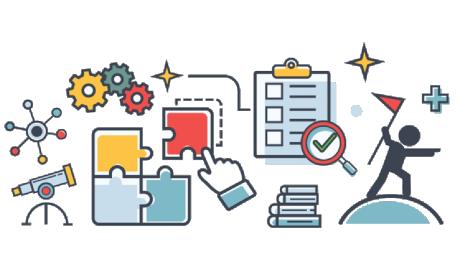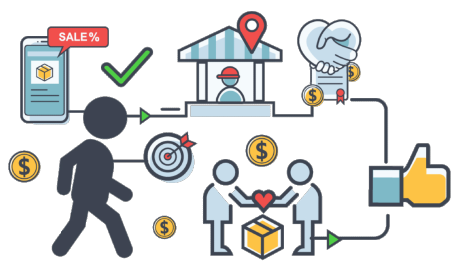
TL;DR SUMMARY:
To grow market share, revenue, or earnings, your brand needs a competitive service advantage that can build brand equity, then convert and extract value
Saying that the world is undergoing a fast-paced transformation is not only stating the obvious but also an understatement. Traditional business models and go-to-market strategies are challenged, and as is the case with the
In today’s retail environment, you must want customers to love your brand for more than just the product’s quality and desirability status to reward your brand with their loyalty.
Adaptiive proposes a new deal where manufacturers take on a lead role in curating their customer brand experience, enabling their retail partners to consistently perform better at selling their branded products and servicing their customers. Doing so transparently and collaboratively, at scale, is the tricky part. Unfortunately, retail partners have varying degrees of skill, resources, and appetite to deliver the buyer experiences your brand should be demanding from them. Only the manufacturer can realistically facilitate this win-win-win outcome for consumers, retailers, and the brand.
While a “happy customers and successful partners make brands thrive” narrative is undoubtedly true, it hides in plain sight the need for a complex digital business transformation we call service-led revenue transformation. Adaptiive offers multidisciplinary skills and experience needed to achieve rapid organic growth in market share and profitable revenue using a revenue transformation framework that balances the art of business (focusing on the culture and necessary behaviors through structures and processes) with the science (more systems and analytics oriented).
While we discuss the why and what questions for the rapid organic growth in market share, revenue, and earnings of a
THE CHALLENGE:
An outdated industry distribution model limits your brand's competitiveness needed for sustained organic growth in market share and profitable revenue
Manufacturers increasingly find themselves blindsided by limited visibility into and little control over an often fragmented, frictional, and inconsistent customer service experience delivered by retailers in the moments that matter most when they market, sell, install, and service your branded products.
Brands are, in general, relatively undifferentiated in terms of service and go-to-market strategies, resulting in brand experiences that are often forgettable, if not undesirable, compared to more evolved service-led industries. However, we understand the role that extreme price complexity, caused by hundreds of locally sourced accessories and services, plays in the industry persisting with an outdated distribution model established decades before the advent of the internet.
Dealer networks were once instrumental in providing access to markets needed to scale and grow. However, the past decade has seen consumer behaviors and expectations evolve to the point where buyer experience is now the most important battleground for growth. And since manufacturers have little to no control here, this shift exposes their over-reliance on independent third parties to deliver their brand experience as a significant inhibitor to their future organic growth.
Click on the individual industry challenges listed below to view their context…
Manufacturers are mostly two or three degrees removed from customers using their products
Retailer price quote formats and quality are inconsistent, and the response times poor
Excessive fulfillment lead times create poor buyer experiences that fail to build brand equity
Service quality at retailers is inconsistent, weakening brand equity and competitiveness
Brands have limited visibility into and control over quality of service delivery at retailers
Retailers have limited visibility into order progress feedback from production and logistics
Manufacturers lack forward visibility into retailers' sales pipeline and demand data
Brands miss out on dynamic pricing as growth leverage due to a devolved pricing practice
Retailers selling multiple brands pose a substantial conflict of interest risk
Consumer sales: retailers' low conversion rates equal many sales opportunities missed
Fleet sales: many missed opportunities wrt revenue expansion and protection
Vehicle dealership sales: even more revenue expansion and protection chances missed
The degree to which many business leaders may be unaware of many of these issues, and the availability of tools to address them, is surprising. According to a recent Forrester study, seven in 10 operational management and revenue leaders said their revenue process and execution strategies are mature. But, surprisingly, only one in 10 of these same brands’ customers agreed they received an above-average customer experience. This may be something for your brand to reflect on.
Not all of our industry analysis applies equally to all brands, but, unfortunately, the reality is that consumers’ experience of
Our analysis reflects the general industry status quo based on observations made during many “secret shopper” experiences of
THE OPPORTUNITY:
An industry sector waiting for a service-led digital disruption
In an emerging world where the balance of power has shifted to the consumer and their brand experiences, it is clear that the
But, will your brand be the disruptor or the disrupted? The good news, it would seem, is that no one is close to reaching digital disruptor status. The bad news is that you must first disrupt your own business before disrupting the industry.
Simply grabbing control of the buyer experience with an online, direct-to-consumer solution is not the answer. Brands that attempt D2C are likely to run into serious channel conflict unless they have a flat-packed product that can ship for easy self-installation or they’re intent on remaining a hyper-local brand that fits their own product. By and large, manufacturer brands like yours need strong local retail partner networks to market, fit, and service their products.

Forging a "new deal" and finding ways to collaborate better with retail partners
Brands and retailers need to have an open and honest conversation about the value they can contribute to a new, radically changed consumer retail environment. Brands should be looking to take the lead in driving alignment and collaboration across sales channels, enabling every retail partner to be consistently better and more successful at selling their products and servicing their customers.
To this end, manufacturers must make the bold call to take back control of the brand experience and empower retailers to deliver differentiated service experiences at every customer touchpoint. The (multi) million-dollar question, though, is figuring out how to do this transparently and collaboratively with your retail partners. Adaptiive knows the territory and has the experience to assist your business with this transformation.
Online "opportunity calculator" to estimate your brand's organic growth potential
Fill out this easy-to-use calculator form for an online estimate of the top-and bottom-line revenue opportunities specific to your business. It is quite a detailed process that takes between 20 to 30 minutes to complete. We will treat all information as confidential but are also happy to sign an NDA / non-disclosure agreement if you would prefer. If so, please get in touch with us via the online meeting, online chat, email, or phone options provided.
STRATEGIC IMPERATIVE:
To build brand equity at every opportunity using service differentiation with curated experiences, then convert and extract maximum economic value
Taking a closer look at the strategic imperative above, we identify the sources of service differentiation that influence your brand’s future go-to-market model and organic growth strategy. Adaptiive’s revenue transformation work is based on three foundational statements, or ground zero strategic principles discussed below.
Align to omnichannel buyer experiences as the new battleground for growth
The battle for consumers’ hearts and wallets is won and lost on experience. With continued advances in technology, personalized and helpful experiences that touch every aspect of a buyer’s journey are emerging as the future battleground for sustained growth. To curate these customer experiences and gain access to customer data flush with valuable insights, your brand needs to get up close and personal with the consumer, done at scale to be effective. But leading research shows a significant trend emerging where consumers are more frequently found at the intersection of online and offline, shopping between channels. The fact that 82% of consumers can convert in either channel is very significant. The only logical decision is to transform your go-to-market operations to create seamless omnichannel buyer experiences that bridge the gap between online and in-store.
Build brand equity at every opportunity to fuel revenue and earnings growth
Customers find delight in personalized experiences that are conversational, in context, on point, and above all, helpful. It builds “bankable” emotional connections with a significant impact on consumers’ value perception, willingness to pay, and propensity to buy. Manufacturers must want customers to love their brand as much for the delightful service experience as for their product’s quality and desirability status, if not more. But your brand has its work cut out first to “reclaim the customer” before you can even think of emulating the winning customer-first experience standards set by digital leaders in other industries. In pursuit of this, customer-centricity and curated experience design should be central to your thinking.
Leverage dynamic pricing to convert brand equity into maximum economic value
Pricing becomes a strategic and dynamic tool when we recognize that price is not the manufacturer’s to set but rather to discover. Customers indeed set the price based on the perceived value they gain when purchasing a product. Therefore, when you develop a retail price, you in effect only choose your desired margin. But perceived value is subjective and thus open to influence, which underscores the importance of differentiation and brand equity and confirms the need for pricing in the strategy toolbox. It follows that pricing can be optimized, opening opportunities to maximize volume and/or margin. Adaptiive can assist your brand in operationalizing a dynamic near-individualized pricing strategy at scale.
We are fascinated working with consumer psychology and behavioral economics to explore how pricing, perceived value, willingness-to-pay, and price elasticity connect (the many dots between) the fluffiness of experience and customer love to the steeliness of profitability and earnings results. But establishing a service-differentiated competitive advantage that can generate customer love is challenging since its inherent value stems from being rare and difficult to imitate.

THE SOLUTION:
Service-led omnichannel revenue operations for
While “Brands naturally thrive with happy customers and successful partners” may seem like a simple truth, the need for and complexity of a digital service-led revenue transformation hides in plain sight. First and foremost, this initiative is a complex digital business transformation with various touchpoints with other operational functions, but none more important than a “new deal” that needs forging with retail channel partners to collaborate in disrupting the industry’s outdated go-to-market model.
Knowing the territory, Adaptiive offers an innovative and unique growth solution framework combining business strategy with proven better practices borrowed from other industries to deliver a

{Service-led} competitive advantage
The strategy is twofold. Firstly, manufacturers need to build brand equity through service differentiation in the small moments that matter most when branded products get marketed, sold, installed, and serviced. But because these touchpoints occur at the retailer, brands must enable retailers to deliver, at scale, the curated experiences that they want consumers to have. Secondly, when brands can offer CPAQ, they also control their products’ retail price points with scaled dynamic pricing leverage to maximize both the brand’s and retailers’ economic value earned. Read more…
Establishing a competitive service advantage is challenging since, to be sustainable, its inherent value stems from being rare and difficult to imitate. Therefore, service-led revenue transformation needs a “new deal” to find better ways to collaborate with hundreds of retail partners and create a win-win-win for customers, retailers, and the brand. It is clear that while the plan looks straightforward, executing a digital business transformation is complex. See less…
{Omnichannel} bridges the online-offline divide
Omnichannel sales is a better practice tactic we’ve adapted from traditional retail to build experiences that integrate buyers’ physical in-store and online worlds. This sales approach gives customers seamless, personalized, and helpful ways to shop while creating delighted-to-buy from your brand experiences. Creating a seamless flow for consumers between the online and offline worlds, brands need accurate real-time contextual personalization, or what we refer to as individualization. It also gives rise to the breakthrough concept of omnichannel customer experience at scale. Read more…
Omnichannel logistics originated in light-industrial manufacturing with a focus on B2B collaboration to create a pleasure-to-sell for the brand experience. Best practices include exposing data points from the manufacturer’s back-office ERP and other operational systems, offering sellers individualized, automated, and real-time CPAQ, with self-managed order fulfillment workflows and real-time progress updates. The goal is to standardize and improve the seller experience with effortless and fool-proof processes that assist the retailer in consistently delivering the high-quality customer service your brand now demands.
A well-balanced omnichannel battle tactic delivers on three promises. Firstly, it creates wow service experiences designed to meet the consumer’s needs regarding how, where, and when they want to buy. Secondly, it facilitates manufacturer-retailer alignment and collaboration aiming to enable every retail partner to be consistently better and more successful at selling their products and servicing their customers, increasing sales volume, revenue, and margins. And lastly, it creates transparency and flow of information needed to optimize production planning, inventory orchestration, and other operational decisions. See less…
{Revenue operations} enable desired experiences
Revenue operations, or revops, is the multidisciplinary intersection where strategy and tactics meet the operational needs of creating the desired (buyer and seller) experiences that drive predictable revenue growth at profitable margins. The discipline entails the end-to-end design and orchestration of people, processes, data, systems, and analytics domains needed to align operational go-to-market teams to work towards a shared process architecture and unified revenue goals. The revops team is central to the success of the revenue transformation initiative. Read more…
Although revops originated in software-as-a-service, or SaaS, an industry with a recurring revenue model, its revenue expansion and protection goals are equally applicable to the
We don’t recommend cookie-cutting and, therefore, will work with your team to find customized business solutions that address challenges and opportunities particular to your business. This solution will consider factors like current business strategies, the business model, market penetration, the effectiveness of existing operations, ERP and other systems landscape, IT infrastructure, human resource capital, market-specific legislative frameworks, retail partner agreements, and more. See less…
Designed and built {for
It is important to note that, as a consumer durable good with a medium-to high-consideration buyer decision process evident in average 3-week sale cycles, selling your product effectively at scale requires a 4 or 5 touchpoint sales process to maintain customer engagement while “helping” them buy your product. As mentioned, your brand needs to facilitate this as independent retailers can’t, for various reasons. Our CanopiesDirect case study indicates the kind of results that an online and syndicated in-store sales-as-a-service solution for retailers could achieve in your business. Read more…
Each of the
For fleet (B2B) and vehicle dealership (B2B2B2C) markets, the use of account-based experience management best practices is crucial for building relationships that wow customers during (hopefully) more frequent dealings with your brand as they regularly repeat their discreet orders. Adaptiive’s innovative approach models this as recurring revenue using revenue expansion and protection best practices to grow individual trade accounts rapidly. See less…

CASE STUDY:
Will you accept 35% 3yr CAGR (unit sales) growth if offered?
Adaptiive Growth Solutions was the brain’s trust behind CanopiesDirect, operating as an online sales outsourced service provider to Beekman Canopies, South Africa’s premium truck canopy brand. CanopiesDirect soon became Beekman’s best-selling agent and significantly contributed to the manufacturer’s success during the 4-year period from 2016-9. These strong growth results won Beekman’s Top Achiever Award for 2018 and 2019 despite significant handicaps in selling at a 25% price premium over competitors, operating in a depressed economy with an average GDP growth rate of only 0.5% and escalating channel conflict.

Buyer experience, owned
A small team of dedicated inside sales professionals demonstrated the immense power of buyer support or sales assistance as a tactic. Creating extraordinary buyer experiences requires the deliberate orchestration and operationalizing of a customer-positive operating model (i.e. people, processes, systems, and workflows).
Customers could sense, feel, and appreciate this, and rewarded Beekman with their loyalty. Looking at the customer feedback, though, it is interesting to notice how consumers don’t differentiate between retailer and brand. The nuanced feedback from customer John Minnie confirms that consumers will compare your wow brand experience to their best-ever buying experiences.
While we don’t promote a cookie-cutter approach, our experience can help prototype the ecommerce-enabled service component your brand needs for consumer engagement online. Although only part of the overall solution, our online experience demonstrates the power of white-glove service, when delivered at scale, to win the hearts and wallets of consumers in the many small moments that matter most.
Customer love, earned
Customer love is the most desired form of competitive advantage - Oberlo
“I just want to congratulate you all. My experience with your online ordering system has been highly professional and seamless. There are many businesses out there who could learn a thing or two from Beekman about customer service.“ Michael Finch
“There are few companies who understand the power of customer service like Beekman. I’m now sold and already your unpaid sales rep.“ Daniel Mashita
“Best online interactive buy I have made to date. Beekman made it effortless and is really very good at customer updates. Good job.“ John Minnie
Learning from failure
Adaptiive learned many valuable lessons from CanopiesDirect’s eventual failure due to ever-increasing channel conflict. The biggest insight gained was that brands should not compete with retailers online, neither directly nor through independent third parties. Instead, brands should set online up as a sales-as-a-service capability in support of brick-and-mortar retailers.
While it is easy to embrace the notion that consumers now regularly frequent the intersection of online and offline, it takes commitment to transformation to deal with the implications that require a rethink of the channel strategy. Beekman management chose not to integrate the online-to-offline strategic model in their business, and we subsequently parted ways in February 2020.


